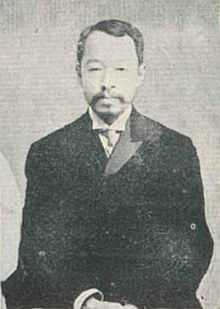Park Yeong-hyo
| Park Yeong-hyo | |
|---|---|
 | |
| Born |
1861 Suwon, Joseon (now Suwon, South Korea) |
| Died |
September 21, 1939 Keijo, Japanese Korea (now Seoul, South Korea) |
| Nationality | Korean |
| Occupation | Politician |
| Park Yeong-hyo | |
| Hangul | 박영효 |
|---|---|
| Hanja | 朴泳孝 |
| Revised Romanization | Bak Yeong-hyo |
| McCune–Reischauer | Pak Yŏng-hyo |
| Pen name | |
| Hangul | 춘고 or 현현거사 |
| Hanja | 春皐 or 玄玄居士 |
| Revised Romanization | Chun-go or Hyeonhyeon-geosa |
| McCune–Reischauer | Ch'un-ko or Hyǒnhyǒn-kǒsa |
| Courtesy name | |
| Hangul | 자순 |
| Hanja | 子純 |
| Revised Romanization | Jasun |
| McCune–Reischauer | Chasun |
|
Japanese name: Yamasaki Eiharu (山崎永春) | |
Park Yeong-hyo (1861 – September 21, 1939) was a Korean politician of the Joseon Dynasty period, enlightenment activist, diplomat and pro-Japanese collaborator. Park was one of the organizers of the Gapsin coup of 1884, in which progressive political elements attempted to overthrow the conservative Korean government. His courtesy name was Chungo, Hyeonhyeongeosa, and he later held the title of Count of Geumryung. Park was married to the Princess Yeonghye(영혜공주 ; 永惠翁主), the illegitimate daughter of King Cheoljong, the twenty-fifth king of the Joseon Dynasty.
Early life and education
Park was born in Suwon, south of Seoul. Together with Kim Ok-gyun, he was a strong supporter of the Dongnipdang, or “Enlightenment Party”, which sought to reform the Korean government, economy, and military by incorporating Western technology and methodology, so that Korea would become stable enough in time to withstand increasing foreign encroachment. He accompanied Kim on his visit to Tokyo, meeting with various influential Japanese politicians, including Fukuzawa Yukichi
Career
Park is credited with creating the first Korean national flag, in 1882.[1]
Gapsin Coup
Park was one of the leaders of the 1884 Gapsin Coup that attempted to overthrow the Korean government and institute Western-style reforms. The coup attempt lasted only three days before its suppression by Chinese troops. Park was forced to flee to exile in Japan, where he initially stayed with Fukuzawa Yukichi, before moving on to Kobe.
Subsequent career
Park served briefly as Interior Minister in 1895, playing an important role in opening up Korea. However, following the Gabo Reform and the assassination of Queen Min, Park fled to exile in Japan, where he remained until 1907. On his return, he accepted the post of Royal Household Minister under Ye Wanyong.
Following the Japan-Korea Treaty of 1910, in which Korea was annexed to the Empire of Japan, Park was awarded with the kazoku title of marquess (koshaku) in the Japanese peerage, and a seat in the House of Peers in the Diet of Japan. He served as Director of the Bank of Chosen in 1918, Chairman of the Korean Economic Association in 1919, first president of the The Dong-a Ilbo newspaper in 1920, president of the Kyungbang Corporation, chairman of the Korea Industrialization Bank in 1921, and advisor to the Government-General of Korea’s Central Institute. In 1935, he was listed as one of the 353 most prominent Koreans.
Writings
- Sahwa giryak (사화기략, 使和記略)
See also
- Lee Wan-yong
- Park Je-sun
- Yun Chi-ho
References
External links
| Wikisource has original works written by or about: Park Yeong-hyo |
- Park Young-hyo:Daum (Korean)
- Park Young-hyo:Korean historical People's Information (Korean)
- Park Young-hyo:navercast (Korean)
- Park Young-hyo:naver
- Park Young-hyo:nate